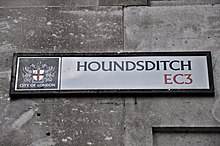Odonymy in the United Kingdom
Odonymy refers to the street or road naming conventions in the toponymy of the United Kingdom.
History
[edit]
Many towns (particularly in England) will refer to their main thoroughfare as the High Street or Main Street, and many of the ways leading off it will be suffixed "Road".
In the City of London, according to tradition, there are no "Roads"; all the streets there are called "Street", "Lane", "Court", "Hill", "Row" or "Alley", or have no suffix (e.g. Cheapside). However, since 1994, part of Goswell Road now lies in the City of London, making this a unique anomaly.[1]
Culture
[edit]Some older road names that were created in an innocuous or matter-of-fact way, and that were accepted at that time, are nowadays considered rude.[2]
Road numbering
[edit]List
[edit]London
[edit]- Street names of Belgravia
- Street names of Bloomsbury
- Street names of Clerkenwell and Finsbury
- Street names of Covent Garden
- Street names of Fitzrovia
- Street names of Holborn
- Street names of Kennington and Lambeth
- Street names of Lisson Grove
- Street names of Marylebone
- Street names of Mayfair
- Street names of Pimlico and Victoria
- Street names of Regent's Park
- Street names of Sheffield
- Street names of Soho
- Street names of Southwark
- Street names of the City of London
- Street names of Vauxhall
- Street names of Waterloo
- Street names of Westminster
Statistics
[edit]The top 15 most-common street names are:[3]
- High Street
- Station Road
- Main Street
- Park Road
- Church Road
- Church Street
- London Road
- Victoria Road
- Green Lane
- Manor Road
- Church Lane
- Park Avenue
- The Avenue
- The Crescent
- Queens Road
References
[edit]- ^ "Why there's not a single Road in the City of London". The Londonist. 15 August 2012. Retrieved 19 April 2016.
- ^ Smith, Oliver (3 October 2017). "Are Britain's rude road names under threat?". The Telegraph. ISSN 0307-1235. Retrieved 26 March 2021.
- ^ "The Most Common Street Names In The UK". The Fact Site. 21 March 2009. Retrieved 26 March 2021.
